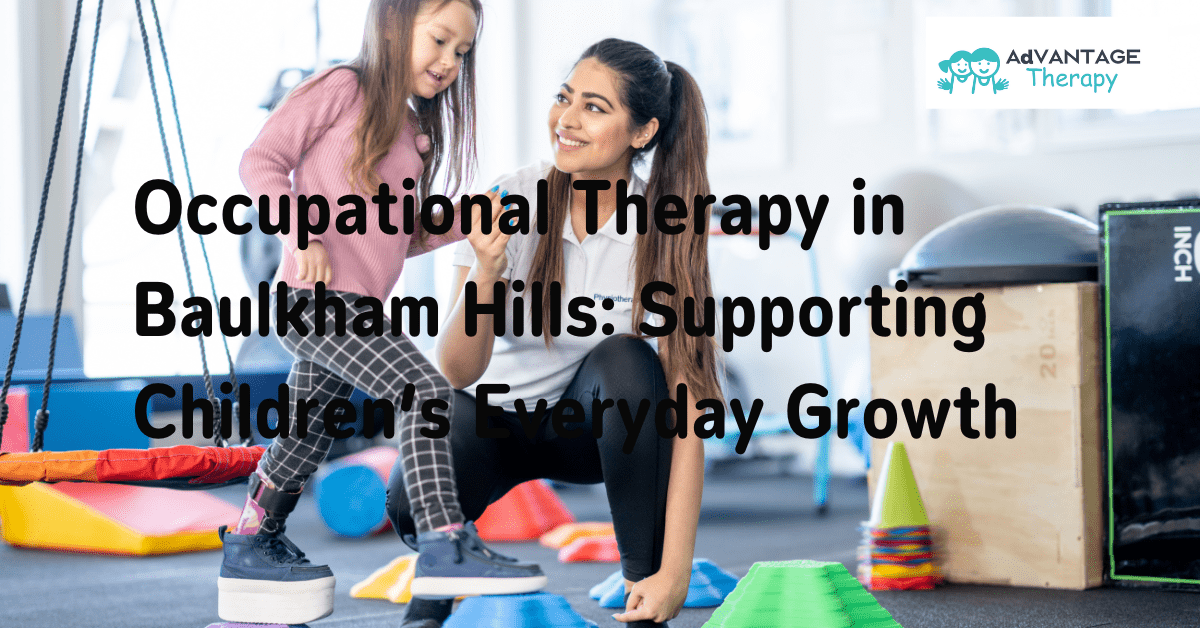Occupational Therapy (OT) helps individuals, including children, address a variety of challenges, ranging from developmental delays to sensory processing issues. For instance, occupational therapy focuses on helping children build the fundamental skills required for routine tasks like dressing, eating, writing, and playing with ease and confidence. The ultimate goal is to enhance their independence and improve their overall quality of life.
If you are a parent, we can understand your concerns and confusion regarding OT sessions. This guide will help you understand what is occupational therapy and how it can positively impact your child’s development.
What is Occupational Therapy, and Who Needs It?
Occupational Therapy is a specialized form of healthcare that focuses on helping develop and enhance the skills necessary for daily life activities. The term “occupational” refers to the various tasks that make up a child’s day, encompassing everything from self-care activities to leisure pursuits, educational activities, and social interactions.

What sets occupational therapy apart is its holistic approach. Occupational therapists consider physical, cognitive, emotional, and environmental factors to tailor interventions suitable for each child’s unique needs. This comprehensive perspective ensures that children receive personalized support to thrive in all aspects of their lives.
Children with any of the following health issues may require occupational therapy to get better at performing routine activities:
- Sensory Processing Disorders: Feels difficulties in processing sensory information, such as overreacting to bright lights, loud sounds, or textures.
- Fine and Gross Motor Skill Delays: Struggles with tasks like tying shoelaces or holding a pencil, signaling challenges in motor skills.
- Autism Spectrum Disorders: Faces challenges in social interaction, communication, and behaviour, like difficulty making eye contact or adapting to changes.
- Developmental Delays: Has issues like delays in meeting age-appropriate milestones, such as late speech or walking.
- Attention Deficit Hyperactivity Disorder (ADHD): Struggles with attention, impulse control, and organization, like difficulty focusing or impulsively interrupting.
- Learning Disabilities: Challenges in academic tasks like handwriting or reading, such as difficulty forming sentences.
- Physical Disabilities: Requires need for support in mobility, adaptive techniques, and daily living activities, such as difficulty walking or performing self-care tasks.
- Behavioural Issues: Gets annoyed easily, has aggressive outbursts, or has trouble adapting.
We hope that now you have grasped the basic idea of what is occupational therapy. Let’s move forward to grab more insightful details.
How Can Parents Identify if Their Child Needs Occupational Therapy?
Ensuring your child’s optimal development is a priority for any parent, right? Therefore, you need to ensure a proactive involvement in your child’s life, identifying potential occupational challenges that they may be facing.

Here’s what parents can do to identify if their child needs occupational therapy or not:
- Behavioural Observation
Monitor your child’s behaviour for any unusual patterns or difficulties in daily activities. Look for signs of frustration, irritability, or avoidance when engaging in tasks like writing, drawing, or playing with small objects.
- Fine Motor Skills Development Check
Assess your child’s fine motor skills, such as holding a pencil, using scissors, or buttoning clothes. Note if there are delays or struggles in these activities compared to peers of the same age.
- Gross Motor Skills Assessment
Observe your child’s gross motor skills, including coordination, balance, and physical activities like running, jumping, or catching a ball. Notice if there are difficulties or delays in these areas that may impact daily life.
- Sensory Sensitivities Analysis
Pay attention to your child’s response to sensory stimuli, such as sensitivity to light, sound, touch, or textures. Identify if your child displays extreme reactions or aversions to certain sensory experiences.
- Social and Play Skills Assessment
Evaluate your child’s ability to engage in social interactions and play with peers. Notice if there are challenges in making friends, taking turns, or understanding social cues.
- Communication Skills Analysis
Assess your child’s communication skills, including speech and language development. You’ll need to look for signs of difficulty in expressing thoughts, understanding instructions, or forming sentences.
- Academic Performance Check
Review your child’s academic progress and performance in school. Try to identify if there are challenges in tasks such as writing, reading, or organizing school materials.
- Daily Living Skills Analysis
Consider how well your child manages daily tasks such as dressing, feeding, and personal hygiene. Note if there are difficulties in developing independence in these self-care activities.
- Consultation with Teachers and Professionals
Communicate with your child’s teachers and school professionals to gather insights into their behaviour and performance in a structured environment. You may seek input from OT professionals, such as Advantage Therapy’s Occupational Therapists, to gain a comprehensive understanding.
- Developmental Milestones Check
Familiarize yourself with typical developmental milestones for your child’s age. Simply compare your child’s progress to these milestones to identify any significant deviations or delays.
- Parental Intuition
Trust your parental instincts if you sense that your child is facing challenges. Don’t waste your time and consult with healthcare professionals for a more in-depth evaluation.
What are the Benefits of Occupational Therapy for Children?
Occupational therapy (OT) for children is important as it helps develop and improve key skills like motor abilities, sensory processing, and social development. Tailored interventions are placed in action, particularly for children with special needs, while fostering independence and instilling confidence.
Here’s how OT sessions benefit children:
- Enhances Fine and Gross Motor Skills
Occupational therapy will help your child develop better hand-eye coordination and handwriting skills. Activities like drawing, coloring, and playing with small objects will be incorporated into the therapy. At home, you can reinforce these skills through arts and crafts, playing with building blocks, and engaging in activities that involve finger manipulation.
- Improves Sensory Processing
If your child faces challenges with sensory processing, the therapist will use activities exposing them to different textures, sounds, and movements. To support this at home, consider creating a sensory-friendly environment with sensory bins, calming routines, and tools like stress balls or fidget spinners.
- Enhances Cognitive Abilities
Through puzzles, memory games, and problem-solving activities, occupational therapy will stimulate your child’s cognitive skills. At home, you can encourage cognitive development through board games, reading, and interactive play that challenges their thinking and reasoning.
- Promotes Independence in Daily Activities
If your child needs assistance with dressing independently, the therapist will work on tasks like buttoning and zipping. Support this at home by choosing clothes with easy closures, breaking down the dressing process into smaller steps, and offering positive reinforcement.
- Supports Social and Emotional Development
Occupational therapy will focus on activities encouraging turn-taking, sharing, and communication to enhance social skills. At home, you can foster social development through playdates, encouraging conversations, and modeling positive social behaviors.
- Assists in Academic Success
If your child struggles with sitting still or focusing in class, the therapist may suggest strategies such as fidget tools or sensory breaks. Collaborate with teachers to implement these strategies and create a conducive study environment at home.
- Addresses Behavioral Challenges
If your child exhibits behavioral challenges, the therapist will explore underlying sensory or emotional regulation issues. Work with the therapist to identify triggers, establish consistent routines, and implement positive reinforcement techniques to manage behavior.
- Customized Interventions for Individual Needs
Each child is unique, and the therapist will tailor interventions accordingly. Communicate openly with the therapist, providing insights into your child’s strengths and challenges at home, ensuring that the therapy plan is personalized and effective.
- Early Intervention for Developmental Delays
If you notice any delays in your child’s development, seek professional advice for early intervention through occupational therapy. Actively participate in the therapy process to address concerns and support your child’s overall development.
- Supports Children with Special Needs
For children with special needs, the therapist will work on sensory integration, communication skills, and daily living activities. Collaborate with the therapist to create a consistent routine, incorporate sensory-friendly strategies, and provide additional support at home.
How Does Occupational Therapy for Kids Work?
In the initial stages, pediatric occupational therapy begins with a comprehensive assessment of the child’s developmental and functional abilities. This assessment, often initiated through referrals from parents or educators, forms the basis for targeted interventions.

The occupational therapists collaborates with parents and caregivers to set specific and achievable goals tailored to the child’s unique challenges. For instance, in order to enhance fine and gross motor skills, therapists employ activities such as handwriting exercises, manipulation of small objects, and coordination games. Whereas for sensory integration challenges, techniques may include activities that expose the child to different textures, sounds, and movements to improve sensory processing.
Various play-based interventions, incorporating therapeutic toys and tools, are commonly used to make the sessions engaging for the child while addressing specific developmental needs.
Throughout the process, parent involvement is crucial, and therapists provide guidance on integrating therapeutic activities into the child’s daily routine. Regular monitoring is ensured, allowing for adjustments to the treatment plan while aligning the progress with the established goals.
As the child advances, the OT therapist works on transition planning, preparing the child to apply learned skills in everyday situations. All this is done while fostering independence and long-term success.
It is worth noting that effective communication and collaboration with other professionals, such as speech therapists or educators, significantly contribute to a holistic approach to supporting the child’s overall development.
Talk to Our Occupational Therapist Now
After understanding “What is Occupational Therapy,” now you must have concerns about your child’s development, right? If you’re considering occupational therapy, don’t hesitate to reach out to our experienced occupational therapists, who provide the best Occupational Therapy services
via Info@advantagetherapy.com.au.
Remember that early intervention and personalized care can make a significant difference in your child’s journey towards achieving their full potential. Our team is here to support you every step of the way.





